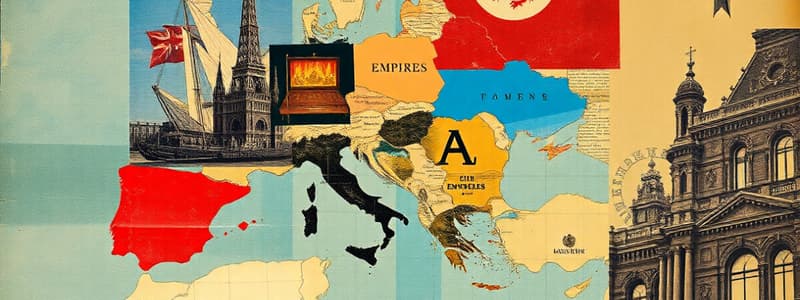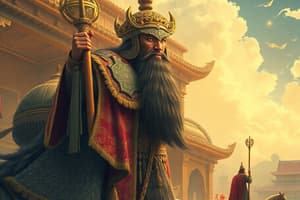Podcast
Questions and Answers
What was a significant advancement that spread through Dar al-Islam?
What was a significant advancement that spread through Dar al-Islam?
- The creation of gunpowder
- Advances in medicine (correct)
- The invention of the compass
- Development of the printing press
The Aztec Empire was known for its mit'a labor system.
The Aztec Empire was known for its mit'a labor system.
False (B)
Which trade route facilitated the exchange of luxury goods like silk and porcelain?
Which trade route facilitated the exchange of luxury goods like silk and porcelain?
Silk Roads
The Ottoman Empire utilized the _________ system to staff its military and government.
The Ottoman Empire utilized the _________ system to staff its military and government.
Match the empire with its cultural/religious characteristic:
Match the empire with its cultural/religious characteristic:
Which of the following motivated European exploration during the period of transoceanic interconnections?
Which of the following motivated European exploration during the period of transoceanic interconnections?
The Columbian Exchange only involved the transfer of crops from the Americas to Europe.
The Columbian Exchange only involved the transfer of crops from the Americas to Europe.
What was the name of the forced journey of enslaved Africans across the Atlantic Ocean?
What was the name of the forced journey of enslaved Africans across the Atlantic Ocean?
Enlightenment thinkers like Locke, Rousseau, and Voltaire questioned _________ and religion.
Enlightenment thinkers like Locke, Rousseau, and Voltaire questioned _________ and religion.
Match the revolution with its corresponding year:
Match the revolution with its corresponding year:
In which country did the Industrial Revolution begin?
In which country did the Industrial Revolution begin?
The Berlin Conference led to increased cooperation and harmony among European powers in Africa.
The Berlin Conference led to increased cooperation and harmony among European powers in Africa.
What ideology contributed to the social roles expanding for women in factories and early suffrage movements during industrialization?
What ideology contributed to the social roles expanding for women in factories and early suffrage movements during industrialization?
The acronym MAIN, representing Militarism, Alliances, Imperialism, and ________, explains the causes of World War I.
The acronym MAIN, representing Militarism, Alliances, Imperialism, and ________, explains the causes of World War I.
Match the leader with their country during the interwar period:
Match the leader with their country during the interwar period:
What doctrine shaped diplomacy and brought the world close to nuclear war?
What doctrine shaped diplomacy and brought the world close to nuclear war?
The Non-Aligned Movement aimed to unite nations under a single superpower during the Cold War.
The Non-Aligned Movement aimed to unite nations under a single superpower during the Cold War.
Name a global institution that facilitated economic cooperation but also sparked backlash in developing countries.
Name a global institution that facilitated economic cooperation but also sparked backlash in developing countries.
Examples of policies of ________ emphasized free markets, deregulation, and privatization.
Examples of policies of ________ emphasized free markets, deregulation, and privatization.
Match global issues with its examples
Match global issues with its examples
Flashcards
Dar al-Islam
Dar al-Islam
Spread through trade routes like the Trans-Saharan and Indian Ocean routes, it experienced advancements in medicine, math, and literature. It fragmented after the Abbasid Caliphate.
Silk Roads Trade
Silk Roads Trade
Luxury goods like silk and porcelain were traded. Caravanserais provided lodging for merchants. Paper, printing, and gunpowder spread.
Indian Ocean Trade
Indian Ocean Trade
Bulk goods like spices and textiles were traded. Monsoon winds facilitated trade. Diasporic communities of Muslim, Chinese, and Jewish merchants formed.
Trans-Saharan Trade
Trans-Saharan Trade
Signup and view all the flashcards
Ottoman Empire
Ottoman Empire
Signup and view all the flashcards
Safavid Empire
Safavid Empire
Signup and view all the flashcards
Mughal Empire
Mughal Empire
Signup and view all the flashcards
Ming and Qing China
Ming and Qing China
Signup and view all the flashcards
European Exploration
European Exploration
Signup and view all the flashcards
Columbian Exchange
Columbian Exchange
Signup and view all the flashcards
Economic Consequences
Economic Consequences
Signup and view all the flashcards
Migration Factors
Migration Factors
Signup and view all the flashcards
World War 1 Causes
World War 1 Causes
Signup and view all the flashcards
World War 1 Aftermath
World War 1 Aftermath
Signup and view all the flashcards
World War 2 Causes & Events
World War 2 Causes & Events
Signup and view all the flashcards
Cold War
Cold War
Signup and view all the flashcards
Nuclear Arms Race
Nuclear Arms Race
Signup and view all the flashcards
Decolonization
Decolonization
Signup and view all the flashcards
Tech Revolution
Tech Revolution
Signup and view all the flashcards
Globalization
Globalization
Signup and view all the flashcards
Study Notes
Unit 1: The Global Tapestry (1200-1450)
-
Key regions during this time were Dar al-Islam, Song China, South/Southeast Asia, Africa, Europe and the Americas
-
Song Dynasty China saw the rise of Confucianism and civil service exams
-
Champa rice, gunpowder, and paper money also became prominent
-
Dar al-Islam expanded via trade routes like the Trans-Saharan and Indian Ocean routes
-
Advances were made in medicine, math, and literature
-
Fragmentation occurred after the Abbasid Caliphate
-
Hinduism and Buddhism were prevalent in South/Southeast Asia
-
The Srivijaya and Majapahit maritime empires emerged
-
Bhakti and Sufi movements spread religion
-
The Mali Empire in Africa, ruled by Mansa Musa, thrived on gold and salt trade
-
Europe was characterized by decentralized feudal states and Catholic Church dominance
-
Centralized monarchies also emerged
-
The Aztec Empire in the Americas operated on a tribute system
-
The Inca Empire utilized the mit'a labor system
Unit 2: Networks of Exchange (1200-1450)
-
The Silk Roads facilitated trade in luxury goods such as silk and porcelain
-
Caravanserais supported travelers
-
Paper, printing, and gunpowder spread along these routes
-
The Indian Ocean trade involved bulk goods like spices and textiles
-
Monsoon winds aided navigation
-
Diasporic communities of Muslim, Chinese, and Jewish merchants formed
-
The Trans-Saharan trade focused on gold and salt
-
The spread of Islam was facilitated by camels and caravans
-
Consequences included urban growth in cities like Samarkand and Timbuktu
-
Technology diffusion of the compass and rudder occurred
-
Cultural diffusion of Islam into Southeast Asia and Africa
Unit 3: Land-Based Empires (1450-1750)
-
Major empires during this time include the Ottoman, Safavid, Mughal, Ming & Qing empires
-
The Ottoman Empire was a gunpowder empire, with the Devshirme system, and Suleiman the Magnificent
-
The Safavid Empire in Persia saw the revival of Shi'a Islam and Persian culture
-
The Mughal Empire in India, under Akbar, practiced religious tolerance and constructed monumental architecture like the Taj Mahal
-
The Ming & Qing Dynasties in China experienced centralization and Great Wall repairs and a Confucian revival, but eventually isolated
-
Russia saw expansion into Siberia under Ivan the Terrible, creating a multiethnic empire
-
Europe saw the rise of Absolutism under leaders like Louis XIV and growing monarchies
-
Art legitimized power, as seen in Ottoman architecture, Mughal miniatures, and Versailles
-
Religious conflict: Protestant Reformation, Thirty Years' War.
Unit 4: Transoceanic Interconnections (1450-1750)
-
European exploration was driven by motivations of God, Gold, and Glory
-
Navigational technology such as the astrolabe and lateen sails were utilized
-
Spain & Portugal established colonies in the Americas and implemented the encomienda system
-
Silver mining in Potosi was significant
-
The Columbian Exchange involved the exchange of crops like potatoes and maize
-
Animals like horses were introduced
-
Diseases like smallpox spread
-
Enslaved labor was utilized
-
The Atlantic Slave Trade involved the Middle Passage, leading to demographic impacts on Africa
-
Mercantilism and Joint-Stock Companies like the VOC (Dutch East India Company) and British East India Company were prominent
-
Resistance occurred through Maroon societies and indigenous revolts
Unit 5: Revolutions (1750-1900)
-
Intellectual Movements: Enlightenment (Locke, Rousseau, Voltaire) questioned monarchy & religion.
-
Political Revolutions:
-
The American Revolution took place in 1776
-
The French Revolution in 1789
-
Haitian Revolution in 1804
-
Latin American Revolution (Bolivar, San Martin)
-
The Industrial Revolution began in Britain with new machines like the spinning jenny and steam engine
-
The factory system emerged, leading to urbanization and environmental impact
-
Social changes included the rise of the working class, feminism (Seneca Falls), and labor unions
-
Imperialism:
-
The "Scramble for Africa" occurred at the Berlin Conference
-
British Raj in India
-
Opium Wars & spheres of influence in China
-
The ideology of White Man's Burden and Social Darwinism spread
-
Resistance movements included the Zulu, Sepoy Rebellion, and Boxer Rebellion
Unit 6: Consequences of Industrialization (1750-1900)
-
Global capitalism and transnational businesses like HSBC and Unilever emerged economically
-
Export economies in colonies focused on resources like rubber, palm oil, and copper
-
Migration occurred due to push-pull factors like poverty and famine
-
Indentured servitude of groups like Indians and Chinese occurred
-
Ethnic enclaves like Chinatown and Little Italy formed
-
Socially there were urban problems and reform movements
-
The global spread of education and new ideologies like Marxism occurred
-
Women's roles expanded in factories, and early suffrage movements began
Unit 7: Global Conflict (1900-1950)
-
World War 1:
-
Causes: MAIN (Militarism, Alliances, Imperialism, Nationalism).
-
Total war, trench warfare, new technology machine uns oison as.
-
End: Treaty of Versailles, League of Nations, rise of resentment in Germany. Interwar Period
-
Great Depression, rise of authoritarian regimes (Hitler, Mussolini, Stalin)
-
Anti-colonial movements (Gandhi in India, Turkish independence under Atatürk).
-
World War 11:
-
Causes: Axis aggression, failure of appeasement
-
Holocaust, total war, atomic bomb, United Nations founded
-
Decolonization movements intensify post-war
Unit 8: Cold War and Decolonization (1945-1980)
-
A bipolar world order emerged as the U.S. and USSR competed for global influence
-
The Cold War was an ideological conflict between capitalism (U.S.) and communism (USSR)
-
Direct war was avoided, but proxy wars were fought in Korea and Vietnam
-
The Nuclear Arms Race was characterized by MAD (Mutually Assured Destruction)
-
Decolonization occurred as colonies in Asia, Africa, and the Middle East gained independence
-
India, Algeria, and Ghana led major movements
-
The Non-Aligned Movement saw many new nations avoiding siding with either superpower
-
Cultural and Social Shifts: Civil Rights Movement in the U.S., second-wave feminism, and youth-led protests (1968) challenged global norms.
Unit 9: Globalization (1980-Present)
-
Economic Globalization: Policies of neoliberalism (Reagan in the U.S., Thatcher in the UK) emphasized free markets, deregulation, and privatization. Global institutions like the IMF, World Bank, and WTO facilitated economic cooperation but also sparked backlash in developing countries.
-
The rise of the internet, personal computing, mobile phones, and satellite communication transformed business, education, and social interaction worldwide
-
Cultural Exchange: Global brands (McDonald's, Nike), music (hip-hop, K-pop), film, and sporting events contributed to a shared global culture
-
Migration and Diasporas: Increased migration for work and asylum created multicultural societies and global diasporas
-
Rising concerns about global warming, deforestation, and pollution led to international agreements
-
The environmental movement gained global traction.
-
The The HIV/AIDS epidemic, later the COVID-19 pandemic, highlighted global vulnerabilities and spurred cooperation through organizations like the World Health Organization
-
Social Movements: Human rights expanded with new waves of feminist activism, LGBTQ+ advocacy, anti-globalization protests, and Indigenous rights campaigns
-
Social media became a tool for global activism and awareness.
Studying That Suits You
Use AI to generate personalized quizzes and flashcards to suit your learning preferences.




